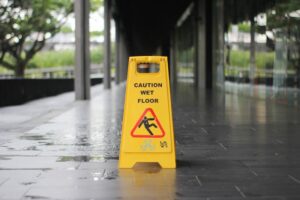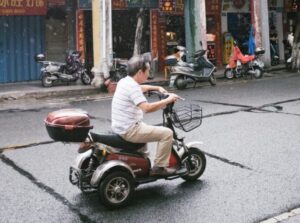Page Contents
Fall is a common and serious health risk for elderly individuals due to various reasons, such as changes in balance, vision, muscle strength, reflexes, blood pressure, etc.
Fall can lead to severe and permanent injuries, impaired quality of life, and sometimes even death.

Fall statistics
Statistics show that falls are a leading cause of injury and death in ageing population.
- According to the Centers for Disease Control and Prevention (CDC), one out of four older adults (age 65 and older) falls each year.
- Falls are the leading cause of both fatal and nonfatal injuries in the elderly population.
- In 2019, over 39,000 older adults died as a result of falls in the United States, and millions more were treated in emergency rooms for nonfatal fall-related injuries.
- The risk of falling increases with age, with those age 85 and older having the highest risk.
These statistics highlight the need for increased awareness and the importance of fall prevention in the elderly cohort.
Why do elderly people fall?
Various key factors that contribute to falls among the elderly people, these include:
- Physical factors
Physical factors such as poor balance, weak muscles (sarcopenia), and poor vision can directly lead to falls. Under the influence of alcohol, drunkenness can cause confusion, slow reflexes, and balancing problems. - Medications
Certain medications, such as sedatives, blood pressure medications, and antidepressants, can increase the risk of falls. It’s important for elderly individuals to discuss their medications with their healthcare provider to identify if their medications may increase their fall risk. - Environmental factors
Slippery floors, poor lighting, shallow staircase depth, and cluttered living spaces can increase the risk of falls. Some floor tile designs that have poor contrast or illusive patterns can also confused the elderly as they walk. - Health conditions
Certain situations or health conditions, such as poor diabetes management, postural hypotension, vertigo, and Parkinson’s disease, can increase fall risk. - Fear of falling (FOF)
Fear of falling can actually increase the risk of falls, as it leads to decreased physical activity and decreased confidence in one’s ability to move safely.
There are a variety of factors that contribute to fall risk among elderly individuals. Understanding the root causes, and rectify the problems can reduce their risk of falls and allow them to enjoy a safer and more active lifestyle.
Complications that arise from fall
Once there is a fall incident, it can lead to serious and long-lasting complications for the elderly. For example:
- Fractures
Falls are a leading cause of fractures in the elderly, particularly hip fractures. Fractures can lead to pain, reduced mobility, slow recovery of wound, and an increased risk of other health problems. - Other injuries
Falls may also cause bruises and head injuries, including concussions and traumatic brain injuries. These injuries can lead to cognitive and physical disabilities, as well as an increased risk of future fall incidents. - Fear of falling
After experiencing a fall, many elderly people develop a fear of falling that can reduce their confident, mobility, and increase their chances of future falls. - Depression
Falls can lead to depression, particularly if the individual experiences pain, loss of mobility, or social isolation. - Loss of independence
Falls can result in a loss of independence, particularly if the individual is unable to perform activities of daily living (ADLs) and requires long-term nursing care. - High healthcare costs
Falls can result in significant healthcare costs, particularly if hospitalisation or long-term care is required.
Falls leading to the complications show the importance of having fall prevention strategies in the elderly population. By taking precaution steps, the risk of falls and their associated complications can be greatly reduced, helping to keep the elderly safe and healthy.
How you can prevent fall?
Fall prevention is essential for the elderly, as a fall can lead to serious consequences. Some strategies for reducing fall risk in the elderly are listed here:
- Exercise regularly
Regular exercise can help improve balance, strength, and coordination, which can reduce the risk of falls. Exercise such as Tai Chi Quan and Yoga can also help improve reflexes, flexibility, and mobility, which can reduce the risk of tripping or losing balance.

- Review your medications
Some medications can cause dizziness or drowsiness, which can increase the risk of falls. Consult your healthcare provider or pharmacist to review your medications and make any necessary adjustments.
- Watch out for hazards
Watch out for hazards around your living environment, such as loose rugs, cluttered pathways, poor lighting, wet floor, curbs and uneven flooring. Consider removing tripping hazards, installing handrails and grab bars, apply non-slip floor treatment in areas where they may be needed.

- Wear appropriate footwear
Wear shoes that fit well and provide good support. Avoid shoes with high heels or slick soles, tie up loose shoelaces, as they can cause slipping and falling.
- Get regular vision and hearing check-ups
Poor vision or hearing can affect balance and increase fall risk. Get regular check-ups and make sure any necessary corrective measures are taken.

- Using assistive devices
If balance or mobility is an issue, consider using assistive devices such as canes, walking frames, or wheelchairs to help prevent falls.
- Reduce dependency on Personal Mobility Vehicle (PMV)
Many people (young or old, ambulant or handicapped) are using PMV as a means of short-distance commuting. Over-reliance on PMV can eventually weaken your muscles and increase your chances of fall.

Falls are not an inevitable part of ageing. By taking precautionary steps, such as regular exercise and hazard reduction, the risk of falls can be reduced significantly, this will eventually keep the elderly safe, ambulatory and healthy.
Conclusion
In the event when fall happens, it is important to know how to respond.
- If an elderly person does fall, it’s important to respond calmly and appropriately. Observe their consciousness level, check if they are alert.
- Ask if they are in pain or injured, seek immediate medical attention if necessary. If they are able to get up on their own, help them slowly and carefully to avoid further injury.
- Allow the elderly person to move their own limbs and body. In the event of inability to move certain part or angle, it may imply serious injuries such as fractures and nerve injuries.
- If the elderly is feeling drowsy, turn him / her gently to one side, remove dentures or food from the mouths.
- It may be helpful to have a fall risk assessment done by a healthcare provider, especially if the elderly person has a history of falls or other risk factors. This can help identify any specific areas of concern and develop a plan for prevention.
- Make sure that the elderly person knows what to do in case of a fall. This may include having a phone within reach, wearing a medical alert device, and having an emergency contact list.
Remember, falls are not an inevitable part of ageing. With proper precautions and care, it’s possible to minimise the risk of falls and keep elderly individuals safe and healthy.
